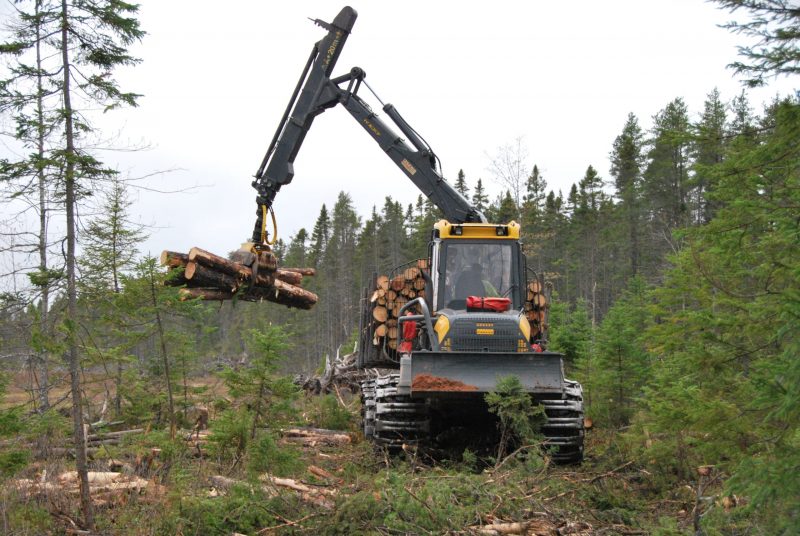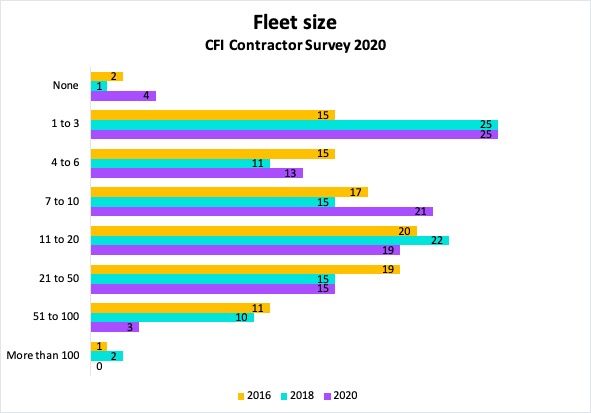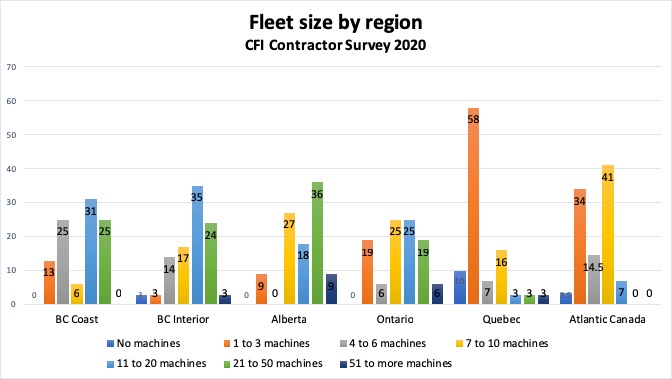
Features
Harvesting
Logging Profiles
Survey snippet 8: Contractors downsize their fleets
September 29, 2020 By Ellen Cools

As more forestry machines are built with sensors, increased fuel efficiency, and greater operator comfort in mind, the price obviously goes up. This could help explain why the percentage of operations with 21 or more machines has continued to drop from 31 per cent in 2016, 26 per cent in 2018 and now just 18 per cent in 2020.
Keeping costs down is key as profit margins become narrower, and decreasing the size of the fleet can also help in this regard.
Just as in 2018, a quarter of loggers who took part in CFI’s 2020 Contractor Survey say they have one to three pieces of equipment (excluding pick-up trucks). The bigger change is in the number of operations that have between seven and 10 machines – 21 per cent of respondents have a fleet of this size, compared to 15 per cent in 2018.
The has also been a slight increase in the number of operations who report having four to six machines – 13 per cent compared in 2020 to 11 per cent in 2018. The corresponding drop is seen among those who own 11 to 20 machines (down three per cent to 19 per cent), those who have 51 to 100 machines (down seven per cent to just three per cent) and those who have more than 100 machines (zero per cent). See how the numbers compare in the chart below.

Percentage of contractors who report machine numbers, excluding pick-ups.
Regionally, contractors in Alberta have the largest fleets, with an estimated 25 pieces of equipment. The majority of loggers (36 per cent) in the province own 21 to 50 machines, 18 per cent own 11 to 20 machines and 27 per cent own seven to 10 machines. Operators in the B.C. Interior come in a close second, with an estimated average of 19 pieces of equipment; 35 per cent of say they own 11 to 20 machines while another 24 per cent own 21 to 50 machines.
Contractors in Ontario come in third, with an estimated average of 18 pieces of equipment. The majority (50 per cent) own between seven and 20 pieces of equipment, followed closely by those who own 21 to 50 machines (19 per cent) and those with one to three machines (19 per cent).
Contractors on the B.C. Coast are limited to fewer than 50 machines. The estimated average fleet size for loggers in this region has dropped to just 16 machines, with the majority (31 per cent) of contractors owning 11 to 20 machines.
In 2020, even more contractors in Quebec own just one to three machines than in 2018 (58 per cent versus 52 per cent). The average estimated pieces of equipment in Quebec, however, is just slightly higher than in Atlantic Canada (seven pieces versus six). This is because in Atlantic Canada, no loggers own more than 20 pieces of machines (compared to six per cent in Quebec). The majority of contractors in Atlantic Canada (41 per cent) own seven to 10, while 34 per cent own between one and three pieces of equipment. See the regional breakdown in the chart below.

Percentage of contractors who report machine numbers, excluding pick-ups, by region.
Missed last week’s survey snippet? Find a collection of reports published to date here. Look for more news from the CFI 2020 Contractor Survey in our eNews over the coming weeks, with a final digital report in December and a summary in the November/December print issue. Be sure to subscribe to our free eNews to get all the latest industry news.
This survey was conducted in April and May 2020 by independent research firm Bramm & Associates, generating 271 replies to a detailed list of questions. Respondents were distributed according to the geographic breakdown of the forest industry, with 44 per cent of respondents in Western Canada, 26 per cent in Quebec and the rest found in Ontario, Atlantic Canada, and central Canada. Within B.C., responses were split between the B.C. Coast and Interior. Many thanks to our sponsors for making this research possible – Hultdins, Tigercat and John Deere.
Print this page